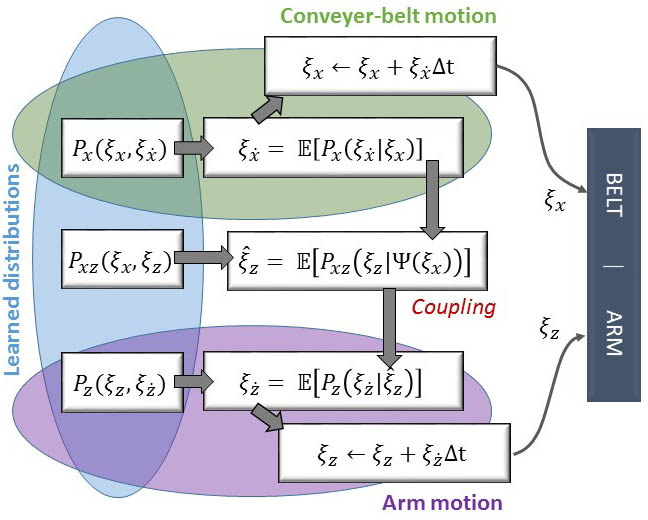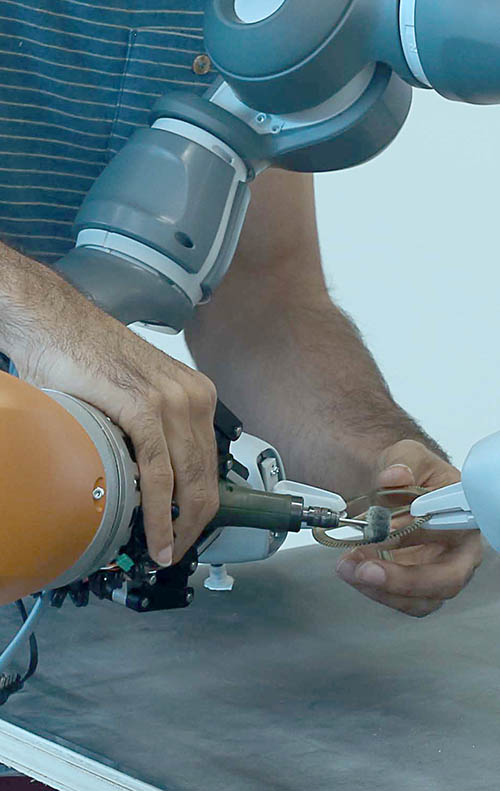| Coordinated motion planning between a robotic arm and a conveyer belt using coupled dynamical systems Karim Zeid (MT) In classical industrial settings, conveyer belts are often used as feeders for the next component of a production line; by moving only in one direction at a constant speed, they move objects from the workspace of one robot to the workspace of another. However, by intelligently controlling the movements of a conveyer belt, robotic technology can provide new possibilities for industrial applications. For instance, by considering the conveyer belt as an additional degree of freedom to the robot, we can expand the workspace of our robotic manipulators. For example, by moving a large object (i.e., larger than the robotic arm’s workspace) on the conveyer, the robotic arm can operate at any region-of-interest on the object. However, this approach requires a precise coordination between the robotic arm and the conveyer belt. For this project, the student will start by implementing two motion generators using DS (dynamical systems) in Matlab. The first motion generator will be used for the robotic arm’s end-effector to reach an object in its workspace, and the second motion generator will be used for the conveyer belt to move an object to a target position. In the second step of the project, in order to achieve a desired coordinated behavior between the robotic arm and the conveyer belt, the student will design a coupling mechanism between the two dynamical systems. Implementations will be tested using Matlab simulations. If there is time and interest, we will have the opportunity to apply the work on a real robot and a conveyer belt. Project: Semester Project Period: 15.02.2017 – 09.06.2017 Section(s): EL IN MA ME MT MX Type: 25% theory, 25% software, 50% testing Knowledge(s): Control systems, Robotics, Matlab, C++ Subject(s): Collaborative robotics, dynamical systems Responsible(s): Mahdi Khoramshahi |  |
| Task-adaptation for assistive robotics using switching dynamical systems Thomas Triquet (MT) Robots are mainly here to assist us with tasks that are repetitive and burdensome. Machine learning and control theory provided us with a variety of techniques to teach our robots to perform such tasks. However, the ability of robots to adapt their tasks to their environment or to the intention of their human-user is limited. Providing robots with such adaptive abilities will unlock new possibilities for assistive robotics. Consider polishing as a task for a robotic arm. The robot learns how to polish from human demonstrations. However, during polishing, the human-user can safely grab the robot and change the polishing direction by applying few repetitions of movements in a new desirable direction. This means that the robots quickly adapts its motions to the intention of the human, thus, assisting him/her in performing the new task. In the first step of this project, the student will implement a simple polishing task for a given surface and a given polishing direction. For this purpose, a dynamical system will be used to generate the desired trajectories for the robotic arm’s end-effector. An impedance controller will be used to control the end-effector which allows the human to safely interact with the robot. In the second part of this project, we will design an adaptive control controller for the polishing direction; i.e., by using the interactional forces, the polishing direction will be adapted to the intention of the human user. Implementations will be tested using Matlab simulations. If there is time and interest, we will have the opportunity to apply the work on a real robot and test it in interaction with humans. Project: Semester Project Period: 15.02.2017 – 09.06.2017 Section(s): EL IN MA ME MT MX Type: 25% theory, 25% software, 50% testing Knowledge(s): Control systems, Robotics, Matlab, C++ Subject(s): Human-robot interaction, dynamical systems Responsible(s): Mahdi Khoramshahi |  |